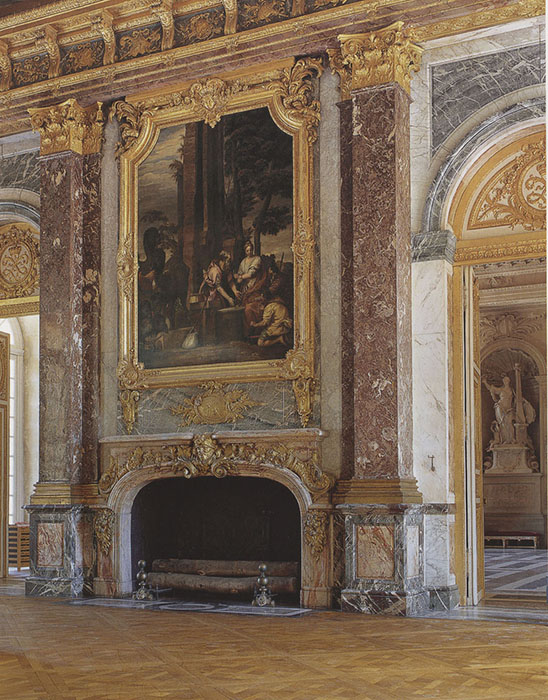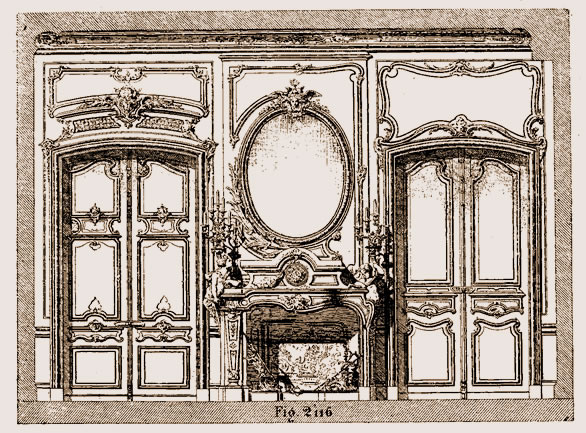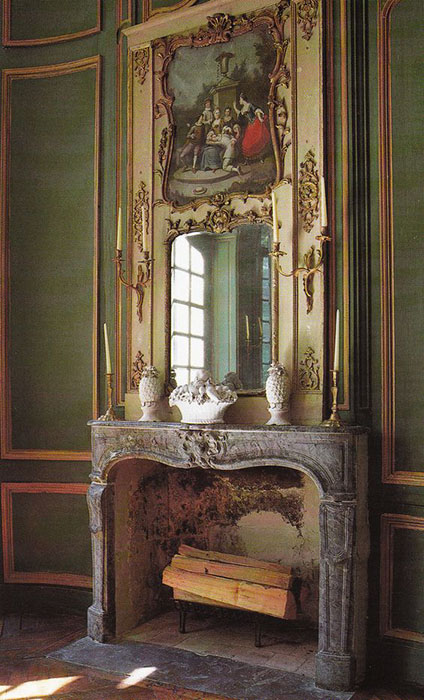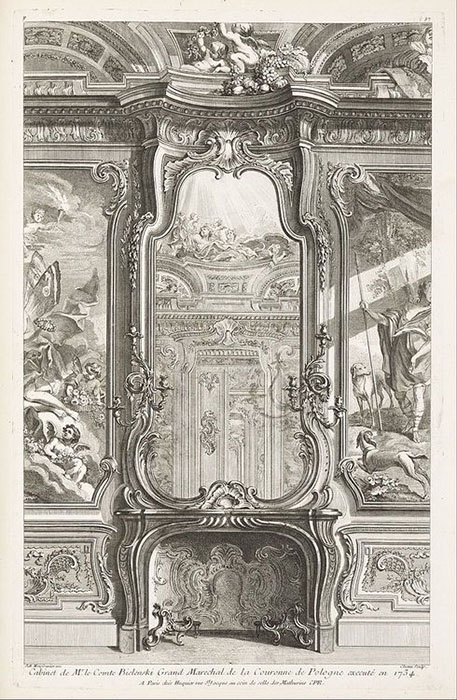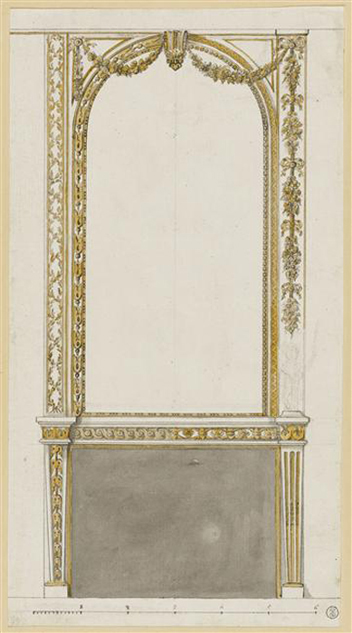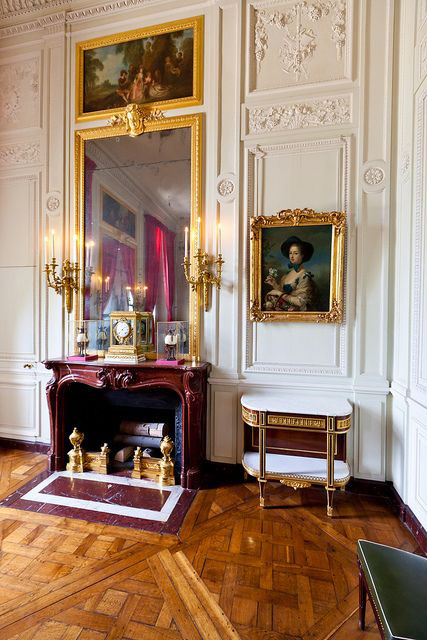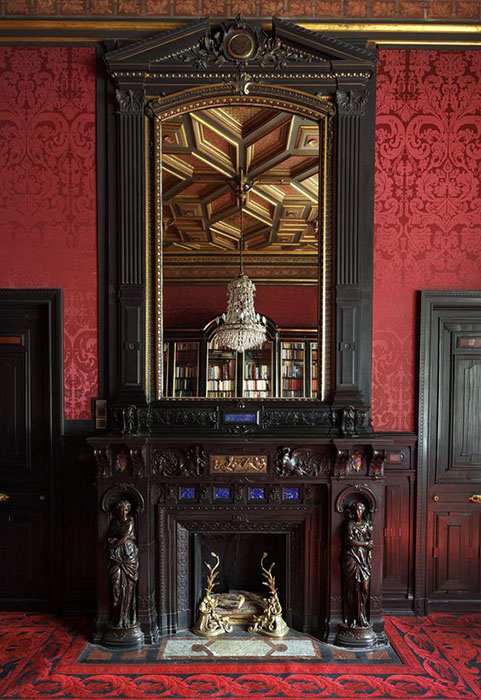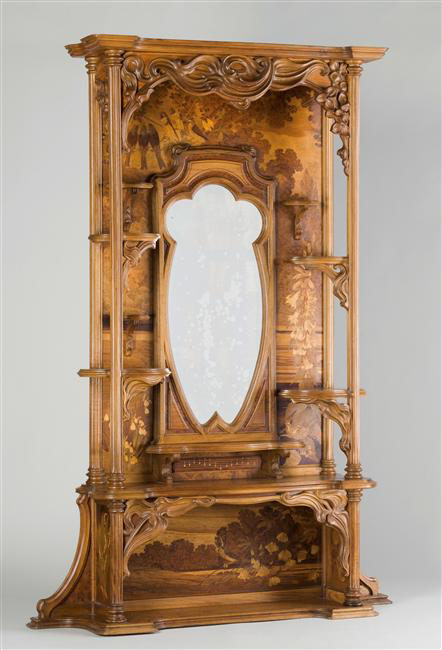Overmantel mirrors
Download PDFDecorating the top of the fireplace, the overmantel mirror (also called "Pierglass" ) can be made of stone or sculpted wood, frame a mirror, a painting, or combine these several elements. Set where used to be chimney breasts and fireplace hoods, the overmantel has been a major concern of designers since 18th century. Never neglected, it reflects each period, and transforms at the whim of styles.
In the Middle Ages, the fireplaces, that first appeared in 9th century, are crowned with massive chimney breasts, sometimes built up to the ceiling, and under which one can stand up, like in the Knight’s Room of the Mont Saint-Michel. The Hôtel Jacques Coeur holds a splendid fireplace whose Gothic breast is in sculpted stone. The top of the fireplace is indeed fit to a sculpted or painted decoration on wood or stone. When the chimney ducts are incorporated inside the walls or outside the buildings in 15th-16th centuries, the mantel gets smaller and accepts a decorative role. The magnificent Renaissance style fireplaces of the Chateau of Blois and of Ecouen illustrate the use of fireplace mantels as a ceremonial surface. Francis I appends his salamander on the mantel, enhanced with gold, which must have been a hypnotic vision in the light coming from the fireplace.
In 17th century, under the development of easel painting, the fireplace mantel and overmantel mirror become two distinctive areas: the mantel still refers to the space surrounding the hearth, topped by a flat shelf, so that the area above is called an "over-mantel". In stone or wood, the overmantel is still joined to the rest. With massive wood sculpted reliefs, the Louis XIII style fireplace creates an opulent frame for the painting above.
With the Louis XIV style, the overmantel serves the Grand Style solemnity. In the Versailles Palace, the illusionists spaces of painting becomes the main element of the overmantel, framed with sculpted ornament, like in the famous Hercules Salon. Jean Marot publishes in 1660 a Book of the Fireplace, illustrated with the numerous variations of the pierglass, a true concern for decoration. Receiving paintings or sculptures, symmetry and geometry are given priority.
In the beginning of 18th century, under the Regency, the aristocracy has the designers imagining light overmantels receiving broad mirrors, that multiply space and create a fairy world with the reflection of chandeliers. The casing is lowered so that one can enjoy the mirrors. Boffrand’s Regence decorations for the Hotel de Soubise are typical, with a multiplication of mirrors decorated with garlands.
Under Louis XV style, foliage and rocaille take over, asymmetry and reverse curves are given priority by designers such as Meissonnier. The overmantel becomes more and more an independent element of the fireplace, that can be removed and changed, but unlike mirrors it is not framed on the lower side. This way, the mantel can also receive paintings to be closely looked at, genre scenes and little allegories in particular, which contribute to the intimate and warm atmosphere of the hearth. It is the time in which overmantel will spread, effect of a frenetic fashion and a strong demand. Fireplace accessories are broadened at the same time: andirons, grates, firescreens, and also clocks and candelabras are placed on the mantel.
The Louis XVI style overmantel embodies the purity of the style, often composed by a huge arched or square mirror, in a delicate white or gilded frame with few or no ornament. Charles de la Fosse announces the Neoclassical style with his antique-inspired sobriety. Sobriety rules as well in Marie-Antoinette ’s Apartments in Trianon, where the decoration obeys to the “square” vogue.
19th century will use all along the ornamental vocabulary of Louis XIV, Louis XV and Louis XVI styles. A very large amount of mirror overmantels have thus extended these princely decorations’ wonder into middle-class indoors.
During the Second Empire, the monumental overmantel is also reinvented, in Neo-Gothic and Neo-Renaissance styles. Marquess Païva’s mansion is decorated with a sculpted wooden overmantel, inspired by the Renaissance, with a broad mirror that has become essential after the Grand Siècle. About 1900, the Art Nouveau of Emile Gallé also designs models that modernize fireplaces.
All the variations imposed on overmantels show they are a key element of decoration, immediately setting a distinctive ambiance and glorifying the fireplace.
Bibliography
Émile Reiber, L'Art pour tous : encyclopédie de l'art industriel et décoratif, A. Morel & cie, 1882.
J. Justin Storck, Le Dictionnaire Pratique de Menuiserie, Ebénisterie, Charpente, facsimilé de l’édition de 1900, Vial, 2002.




